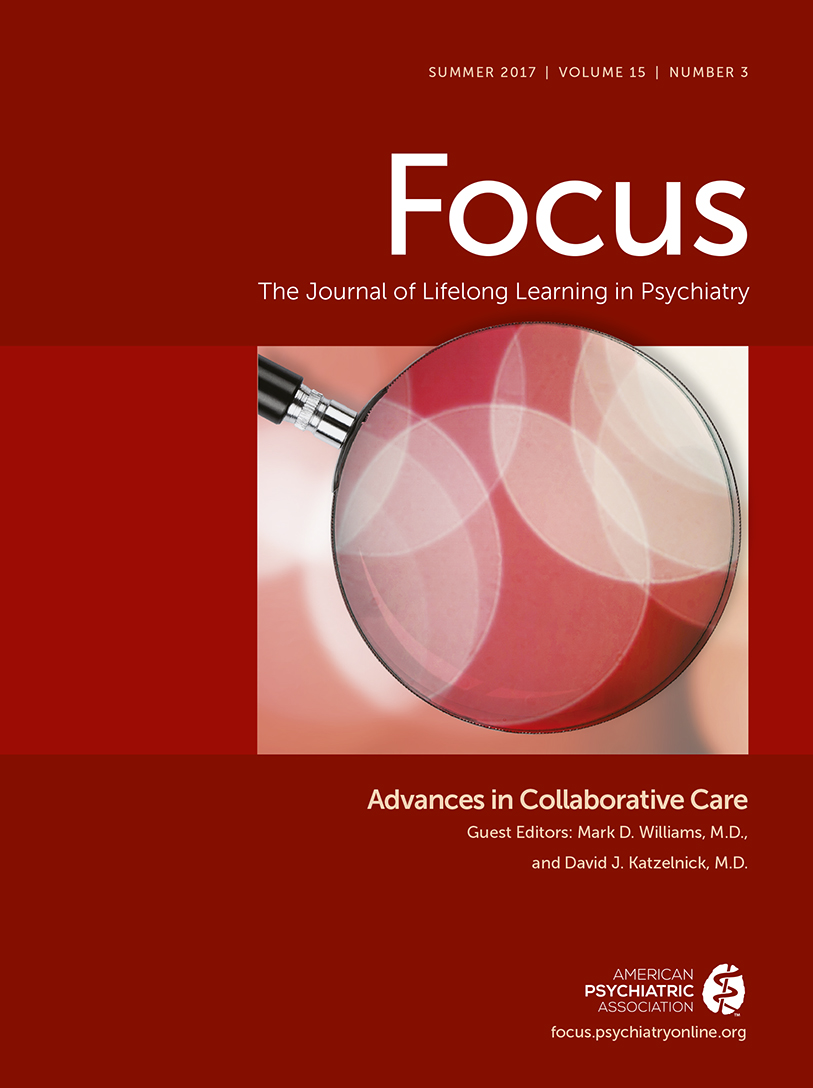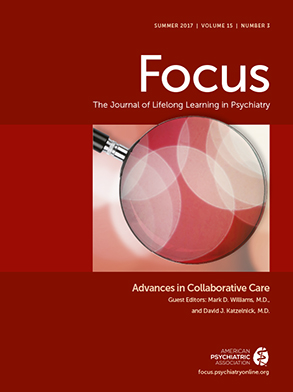Integrated care—the systematic coordination of mental health, substance abuse, and primary care services—has been reported to produce the best outcomes and to be the most effective approach to caring for individuals with multiple health care needs (
3). Collaborative care programs are one approach to integration. Collaborative care includes care coordination and care management; proactive, routine monitoring and treatment with specific target outcomes measured using validated clinical rating scales; and regular, systematic psychiatric reviews and consultation for patients who do not demonstrate the expected levels of clinical improvement (
4). The four essential elements of collaborative care are the provision of care that is (a) team driven, (b) population focused, (c) measurement guided, and (d) evidence based (
3,
4). A collaborative care team is multidisciplinary, distributes roles and tasks, and is responsible for the health outcomes of their patients. It is a population-based model, used to equip the team with tools to manage their population of patients effectively and efficiently. Collaborative care programs have been shown to be both clinically effective and cost-effective for a variety of mental health conditions, in a variety of settings, and when using several payment mechanisms (
4).
Effective communication and teamwork are essential within the collaborative care model to ensure the delivery of high-quality, safe patient care. This successful communication must include the treatment team of physical and mental health providers as well as the patients and families served. Primary care–mental health collaborative care models have demonstrated achievement of the “triple aim” of improved health, improved quality of care, and reduced costs (
5,
6).
Clinical Vignette
Ms. Montes is a 60-year-old widowed bank employee who presented to her PCP with complaints of generalized fatigue, poor sleep, loss of appetite, and poor motivation. She has been ruminating about the possibility that she has cancer, the illness that led to her husband’s death the year before. Ms. Montes has a previous medical history of postpartum depression, hypertension, hyperlipidemia, and deep vein thrombosis, and she was diagnosed as having diabetes three years earlier. Her children are grown and have moved out of state. She has become more reclusive and seldom spends time with friends since the death of her husband. Her score on the nine-item Patient Health Questionnaire (PHQ-9) is 18 (a score of 15–19 suggests moderately severe depression).
Dr. Khan, Ms. Montes’ PCP, practices within a medical home collaborative care setting. He is familiar with Ms. Montes, having provided her with care in the past for her medical conditions, some of which are chronic. He completes a careful physical examination, orders complete blood work, and introduces Ms. Montes to Ms. Rodriguez, the care manager (CM). Ms. Rodriguez asks further diagnostic questions of Ms. Montes about anxiety, depression, suicidality, overall safety, and level of functionality.
Ms. Rodriguez presents Ms. Montes’ case to Dr. Brown, the consulting psychiatrist. Dr. Brown recommends psychotherapy with cognitive-behavioral therapy and a trial of sertraline and reviews dosages and follow-up recommendations. Dr. Khan prescribes the medication to Ms. Montes (after an appropriate review of risks and benefits). Ms. Rodriguez sets up an appointment for cognitive-behavioral therapy as well as a follow-up primary care team appointment in two weeks for Ms. Montes.
Ms. Montes calls Ms. Rodriguez four days later, reporting that she picked up the sertraline and is taking it without side effects but doesn’t feel much different. Ms. Rodriguez reassures Ms. Montes that this is not unusual and that she will need to keep taking the medication for four to six weeks at the right dose before her mood may change. Ms. Rodriguez checks on the status of the appointment for cognitive-behavioral therapy and Ms. Montes confirms that it is scheduled for the next day. She admits she was hoping that the medication would have worked so she wouldn’t need both psychotherapy and medication. Ms. Rodriguez discusses the superior effectiveness of combined medication and psychotherapy and encourages Ms. Montes to keep the appointment. They make a plan to check in once a week.
In four weeks, Ms. Montes’ PHQ-9 score has gone from 18 to 15, which is still in the range of moderately severe depression, and she is tolerating the sertraline without any problems. Dr. Brown, the consulting psychiatrist, recommends titrating the dose to a higher level and continuing to monitor Ms. Montes’ response. Dr. Khan writes the prescription; Ms. Rodriguez confirms that Ms. Montes picked it up at the pharmacy and takes the medicine as directed. Ms. Montes has also started psychotherapy with a collaborating therapist.
After another four weeks, Ms. Montes’ PHQ-9 score is 10 (scores of 10–14 suggest moderate depression). She reports that she is no longer worried that she has cancer and that she is starting to spend time with friends. In spite of these gains, however, Ms. Montes continues to report to Ms. Rodriguez symptoms of negative self-worth, poor-quality sleep, and low energy coupled with overeating—all of which contribute to her current PHQ-9 score. They formulate a plan to begin more regular exercise. Because Ms. Montes’ PHQ-9 score is still above 5, Dr. Brown’s advice is to continue to titrate the sertraline to the maximum daily dosage, continue weekly psychotherapy, and follow up with monthly medication assessments by the PCP.
Collaborative Care Communication Competence
Optimizing patient care communication is essential to providing comprehensive, coordinated, and continuous services to patients. This includes communication between the patient and the provider and communication among the various providers caring for the same patient. Patient-provider communication, a mainstay of psychiatric care, is predominantly relational in nature, requiring active listening and empathic connection to the patient. An increasingly essential additional communication skill is the ability to effectively and efficiently exchange information across services and settings so that appropriate information reaches those who need it, when they need it. Given the involvement of multiple professionals from multiple disciplines, integrated care settings are prone to gaps in both types of communication (
7).
Team building and effective multidisciplinary communication are crucial for providing safe and effective health care—indeed, communication failures are the leading cause of inadvertent patient harm (
8). Patients with multiple health care needs are at particularly high risk of communication failures that lead to adverse events. As health care and the system that delivers it become more complex, the risk of errors increases. For this reason, collaborative care teams need to have standardized, open, and effective methods of communicating to build trust and provide high-quality and safe care to patients (
9).
Medicine has long been a hierarchical environment, in which it may be difficult for some members of the treatment team to feel safe and empowered to speak up. Collaborative care requires a highly functional, mutually respectful team in which each member is responsible for well-specified tasks and each member’s contribution is respected and appreciated. Unlike with more standard forms of clinical care, in a collaborative care setting, the psychiatrist frequently is not meeting one-on-one with the patient. Communicating crucial information and forming close and trusting working relationships within the care team are essential to this care model. The psychiatrist’s role as a consultant is to provide recommendations for patient management. However, the psychiatric role in the collaborative care team may also encompass team building, problem solving, and mental health education to ensure optimal team knowledge and functioning. What may feel like a loss to the psychiatrist in terms of a doctor-patient relationship may be compensated with the opportunity to work in a well-functioning collaborative team and thereby have a positive impact on the larger population of patients served (
8,
9).
Generally, the PCP is the leader within the collaborative care team (
10). The psychiatrist primarily serves as a consultant to the PCP and the CM. Some collaborative care teams also have clinicians (to provide psychotherapy), peer specialists (individuals in mental health recovery who may play a patient-support role), or both. At times, the psychiatrist will meet and personally evaluate the patient; at other times, the psychiatrist will make recommendations based on information from other sources (e.g., the CM, the PCP, the chart). Skills in case formulation, gathering essential information, careful listening, psychoeducation, and effective team-based communication are crucial new skills required of psychiatrists working in collaborative care settings (
7,
10).
The following are communication tips for psychiatrists working in a collaborative care environment:
1.
Form a close working team.
a.
Meet regularly and learn about skills and roles in the team from each team member.
b.
Provide regular constructive feedback to each other regarding methods of improving functioning within the team.
c.
Acknowledge the positive communication skills of team members.
d.
Specify the details of the communication plan and how the team will ensure a safe communication environment for the multidisciplinary working team (e.g., honesty, punctuality, respect).
2.
Clarify the consultation question.
a.
Inquire about the patient’s symptoms and the reason the PCP feels that psychiatric input is required for this patient.
b.
Collaborate in the differential diagnosis—be sure to identify the medical complications of psychiatric illnesses and the psychiatric complications of medical illnesses, and ensure that both are being assessed.
c.
Review the patient’s scores on standardized rating scales, the chief complaint, and presenting symptoms.
3.
Discuss mental health assessment plans.
a.
Work with the team to differentiate the more complex patient, who may require a an individualized face-to-face psychiatric assessment, from the patient for whom the psychiatrist may provide consultation based on information from other team members, rating scales, and chart review.
b.
Determine if more specialized assessments are required (e.g., a dementia workup) and identify the team member who will order these assessments and ensure they follow up on the results.
4.
Make meeting plans.
a.
The psychiatrist and CM should have a regular meeting time to complete patient care reviews and determine which patients are not making expected gains.
b.
Meet regularly with the team to review more complex cases.
5.
Establish accountability.
a.
Ensure each team member knows his or her responsibilities and is accountable for tasks.
b.
Review all patients who are not making appropriate progress and determine the next level of assessment and treatment.
6.
Address any issues in team functioning.
a.
Acknowledge and find solutions for any communication gaps or tensions within the care team.
b.
Provide group support for difficult cases.

